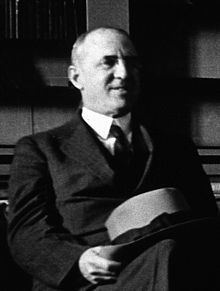Name Lynn Thorndike Siblings Ashley Horace Thorndike | Role Historian | |
 | ||
Died December 28, 1965, New York City, New York, United States Books The History of Medieval Europe, The Place of Magic in the Intelle, A History of Magic and Experime, Little Known Medical, The History of Medieval Europe | ||
Lynn Thorndike (24 July 1882, Lynn, Massachusetts, USA – 28 December 1965, Columbia University Club, New York City) was an American historian of medieval science and alchemy. He was the younger brother of Ashley Horace Thorndike and Edward Lee Thorndike.
Contents
Education and teaching career
Thorndike studied at Wesleyan University, Middletown, Connecticut (Bachelor of Arts, 1902), and then medieval history at Columbia University (Master of Arts 1903, Doctorate 1905). Thorndike's doctoral dissertation (1905) was about "The Place of Magic in the Intellectual History of Europe", which he went on to link with the historical development of experimental science.
He began teaching medieval history at Northwestern University in 1907. He moved to Western Reserve University in 1909 and stayed there until 1924. Columbia University lured him away in fall 1924 and he taught there until he retired from teaching in 1950.
Writing career
After retiring from teaching, Thorndike continued to publish for an additional ten years and in 1957 received the Sarton Medal from the History of Science Society. He served as the president there in 1929 and also served as president of the American Historical Association.
Counter to Swiss historian Jacob Burckhardt who argued that the Italian Renaissance was a separate phase, Thorndike believed that most of the political, social, moral and religious phenomena which are commonly defined as Renaissance seemed to be almost equally characteristic of Italy at any time from the twelfth to the eighteenth centuries.
Among his books on magic and science are: A History of Magic and Experimental Science (8 vol., 1923–58), spanning the period from early Christianity through early modern Europe to the end of the 17th century. In that book, he commented about the best way to find historical truth:
Some investigators of manuscripts, like certain anthropologists and archeologists, seem to think that they attain a higher degree of scholarship, if they propound some novel and improbable theory and adduce a certain amount of evidence for it. This is hardly the direct or rapid method of attaining historical truth.
Another book by Thorndike about magic and science is Science and Thought in the Fifteenth Century (1929). Thorndike also wrote The History of Medieval Europe (1917, 3d ed. 1949) and translated the medieval astronomical textbook De sphaera mundi of Johannes de Sacrobosco.
